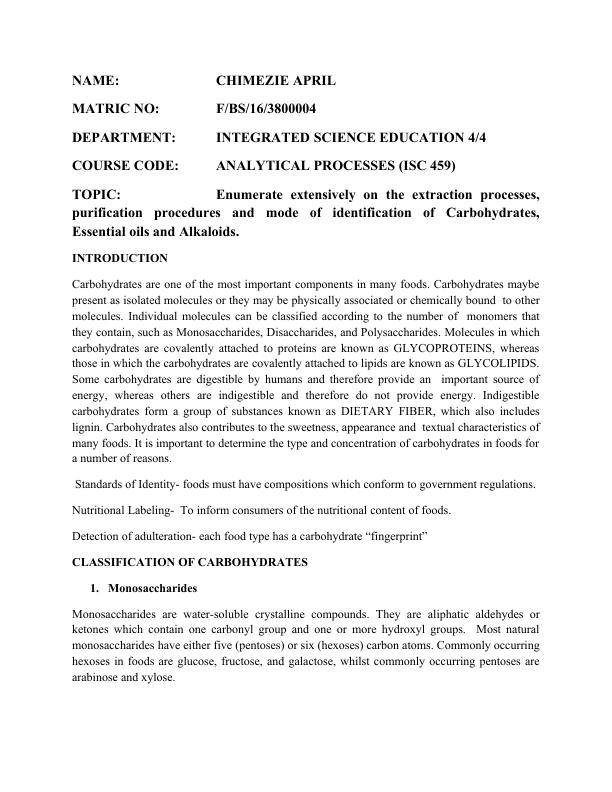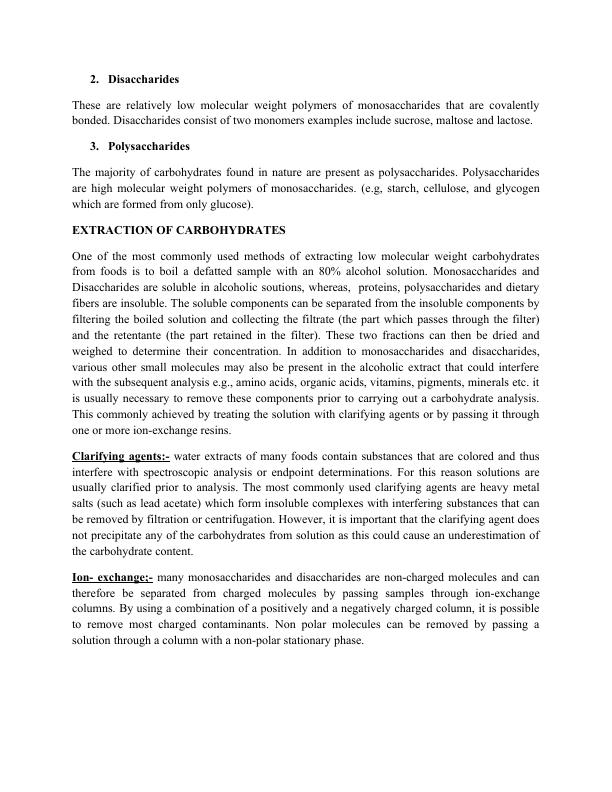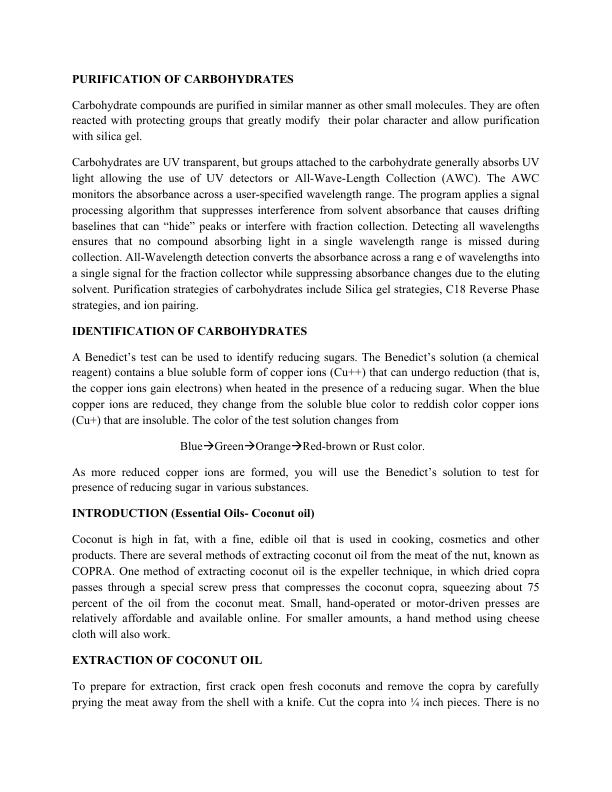ISC 459 Analytical Processes Assignment 2022
7 Pages3025 Words15 Views
Added on 2022-02-09
ISC 459 Analytical Processes Assignment 2022
Added on 2022-02-09
ShareRelated Documents
NAME: CHIMEZIE APRIL
MATRIC NO: F/BS/16/3800004
DEPARTMENT: INTEGRATED SCIENCE EDUCATION 4/4
COURSE CODE: ANALYTICAL PROCESSES (ISC 459)
TOPIC: Enumerate extensively on the extraction processes,
purification procedures and mode of identification of Carbohydrates,
Essential oils and Alkaloids.
INTRODUCTION
Carbohydrates are one of the most important components in many foods. Carbohydrates maybe
present as isolated molecules or they may be physically associated or chemically bound to other
molecules. Individual molecules can be classified according to the number of monomers that
they contain, such as Monosaccharides, Disaccharides, and Polysaccharides. Molecules in which
carbohydrates are covalently attached to proteins are known as GLYCOPROTEINS, whereas
those in which the carbohydrates are covalently attached to lipids are known as GLYCOLIPIDS.
Some carbohydrates are digestible by humans and therefore provide an important source of
energy, whereas others are indigestible and therefore do not provide energy. Indigestible
carbohydrates form a group of substances known as DIETARY FIBER, which also includes
lignin. Carbohydrates also contributes to the sweetness, appearance and textual characteristics of
many foods. It is important to determine the type and concentration of carbohydrates in foods for
a number of reasons.
Standards of Identity- foods must have compositions which conform to government regulations.
Nutritional Labeling- To inform consumers of the nutritional content of foods.
Detection of adulteration- each food type has a carbohydrate “fingerprint”
CLASSIFICATION OF CARBOHYDRATES
1. Monosaccharides
Monosaccharides are water-soluble crystalline compounds. They are aliphatic aldehydes or
ketones which contain one carbonyl group and one or more hydroxyl groups. Most natural
monosaccharides have either five (pentoses) or six (hexoses) carbon atoms. Commonly occurring
hexoses in foods are glucose, fructose, and galactose, whilst commonly occurring pentoses are
arabinose and xylose.
MATRIC NO: F/BS/16/3800004
DEPARTMENT: INTEGRATED SCIENCE EDUCATION 4/4
COURSE CODE: ANALYTICAL PROCESSES (ISC 459)
TOPIC: Enumerate extensively on the extraction processes,
purification procedures and mode of identification of Carbohydrates,
Essential oils and Alkaloids.
INTRODUCTION
Carbohydrates are one of the most important components in many foods. Carbohydrates maybe
present as isolated molecules or they may be physically associated or chemically bound to other
molecules. Individual molecules can be classified according to the number of monomers that
they contain, such as Monosaccharides, Disaccharides, and Polysaccharides. Molecules in which
carbohydrates are covalently attached to proteins are known as GLYCOPROTEINS, whereas
those in which the carbohydrates are covalently attached to lipids are known as GLYCOLIPIDS.
Some carbohydrates are digestible by humans and therefore provide an important source of
energy, whereas others are indigestible and therefore do not provide energy. Indigestible
carbohydrates form a group of substances known as DIETARY FIBER, which also includes
lignin. Carbohydrates also contributes to the sweetness, appearance and textual characteristics of
many foods. It is important to determine the type and concentration of carbohydrates in foods for
a number of reasons.
Standards of Identity- foods must have compositions which conform to government regulations.
Nutritional Labeling- To inform consumers of the nutritional content of foods.
Detection of adulteration- each food type has a carbohydrate “fingerprint”
CLASSIFICATION OF CARBOHYDRATES
1. Monosaccharides
Monosaccharides are water-soluble crystalline compounds. They are aliphatic aldehydes or
ketones which contain one carbonyl group and one or more hydroxyl groups. Most natural
monosaccharides have either five (pentoses) or six (hexoses) carbon atoms. Commonly occurring
hexoses in foods are glucose, fructose, and galactose, whilst commonly occurring pentoses are
arabinose and xylose.

2. Disaccharides
These are relatively low molecular weight polymers of monosaccharides that are covalently
bonded. Disaccharides consist of two monomers examples include sucrose, maltose and lactose.
3. Polysaccharides
The majority of carbohydrates found in nature are present as polysaccharides. Polysaccharides
are high molecular weight polymers of monosaccharides. (e.g, starch, cellulose, and glycogen
which are formed from only glucose).
EXTRACTION OF CARBOHYDRATES
One of the most commonly used methods of extracting low molecular weight carbohydrates
from foods is to boil a defatted sample with an 80% alcohol solution. Monosaccharides and
Disaccharides are soluble in alcoholic soutions, whereas, proteins, polysaccharides and dietary
fibers are insoluble. The soluble components can be separated from the insoluble components by
filtering the boiled solution and collecting the filtrate (the part which passes through the filter)
and the retentante (the part retained in the filter). These two fractions can then be dried and
weighed to determine their concentration. In addition to monosaccharides and disaccharides,
various other small molecules may also be present in the alcoholic extract that could interfere
with the subsequent analysis e.g., amino acids, organic acids, vitamins, pigments, minerals etc. it
is usually necessary to remove these components prior to carrying out a carbohydrate analysis.
This commonly achieved by treating the solution with clarifying agents or by passing it through
one or more ion-exchange resins.
Clarifying agents:- water extracts of many foods contain substances that are colored and thus
interfere with spectroscopic analysis or endpoint determinations. For this reason solutions are
usually clarified prior to analysis. The most commonly used clarifying agents are heavy metal
salts (such as lead acetate) which form insoluble complexes with interfering substances that can
be removed by filtration or centrifugation. However, it is important that the clarifying agent does
not precipitate any of the carbohydrates from solution as this could cause an underestimation of
the carbohydrate content.
Ion- exchange;- many monosaccharides and disaccharides are non-charged molecules and can
therefore be separated from charged molecules by passing samples through ion-exchange
columns. By using a combination of a positively and a negatively charged column, it is possible
to remove most charged contaminants. Non polar molecules can be removed by passing a
solution through a column with a non-polar stationary phase.
These are relatively low molecular weight polymers of monosaccharides that are covalently
bonded. Disaccharides consist of two monomers examples include sucrose, maltose and lactose.
3. Polysaccharides
The majority of carbohydrates found in nature are present as polysaccharides. Polysaccharides
are high molecular weight polymers of monosaccharides. (e.g, starch, cellulose, and glycogen
which are formed from only glucose).
EXTRACTION OF CARBOHYDRATES
One of the most commonly used methods of extracting low molecular weight carbohydrates
from foods is to boil a defatted sample with an 80% alcohol solution. Monosaccharides and
Disaccharides are soluble in alcoholic soutions, whereas, proteins, polysaccharides and dietary
fibers are insoluble. The soluble components can be separated from the insoluble components by
filtering the boiled solution and collecting the filtrate (the part which passes through the filter)
and the retentante (the part retained in the filter). These two fractions can then be dried and
weighed to determine their concentration. In addition to monosaccharides and disaccharides,
various other small molecules may also be present in the alcoholic extract that could interfere
with the subsequent analysis e.g., amino acids, organic acids, vitamins, pigments, minerals etc. it
is usually necessary to remove these components prior to carrying out a carbohydrate analysis.
This commonly achieved by treating the solution with clarifying agents or by passing it through
one or more ion-exchange resins.
Clarifying agents:- water extracts of many foods contain substances that are colored and thus
interfere with spectroscopic analysis or endpoint determinations. For this reason solutions are
usually clarified prior to analysis. The most commonly used clarifying agents are heavy metal
salts (such as lead acetate) which form insoluble complexes with interfering substances that can
be removed by filtration or centrifugation. However, it is important that the clarifying agent does
not precipitate any of the carbohydrates from solution as this could cause an underestimation of
the carbohydrate content.
Ion- exchange;- many monosaccharides and disaccharides are non-charged molecules and can
therefore be separated from charged molecules by passing samples through ion-exchange
columns. By using a combination of a positively and a negatively charged column, it is possible
to remove most charged contaminants. Non polar molecules can be removed by passing a
solution through a column with a non-polar stationary phase.

PURIFICATION OF CARBOHYDRATES
Carbohydrate compounds are purified in similar manner as other small molecules. They are often
reacted with protecting groups that greatly modify their polar character and allow purification
with silica gel.
Carbohydrates are UV transparent, but groups attached to the carbohydrate generally absorbs UV
light allowing the use of UV detectors or All-Wave-Length Collection (AWC). The AWC
monitors the absorbance across a user-specified wavelength range. The program applies a signal
processing algorithm that suppresses interference from solvent absorbance that causes drifting
baselines that can “hide” peaks or interfere with fraction collection. Detecting all wavelengths
ensures that no compound absorbing light in a single wavelength range is missed during
collection. All-Wavelength detection converts the absorbance across a rang e of wavelengths into
a single signal for the fraction collector while suppressing absorbance changes due to the eluting
solvent. Purification strategies of carbohydrates include Silica gel strategies, C18 Reverse Phase
strategies, and ion pairing.
IDENTIFICATION OF CARBOHYDRATES
A Benedict’s test can be used to identify reducing sugars. The Benedict’s solution (a chemical
reagent) contains a blue soluble form of copper ions (Cu++) that can undergo reduction (that is,
the copper ions gain electrons) when heated in the presence of a reducing sugar. When the blue
copper ions are reduced, they change from the soluble blue color to reddish color copper ions
(Cu+) that are insoluble. The color of the test solution changes from
BlueGreenOrangeRed-brown or Rust color.
As more reduced copper ions are formed, you will use the Benedict’s solution to test for
presence of reducing sugar in various substances.
INTRODUCTION (Essential Oils- Coconut oil)
Coconut is high in fat, with a fine, edible oil that is used in cooking, cosmetics and other
products. There are several methods of extracting coconut oil from the meat of the nut, known as
COPRA. One method of extracting coconut oil is the expeller technique, in which dried copra
passes through a special screw press that compresses the coconut copra, squeezing about 75
percent of the oil from the coconut meat. Small, hand-operated or motor-driven presses are
relatively affordable and available online. For smaller amounts, a hand method using cheese
cloth will also work.
EXTRACTION OF COCONUT OIL
To prepare for extraction, first crack open fresh coconuts and remove the copra by carefully
prying the meat away from the shell with a knife. Cut the copra into ¼ inch pieces. There is no
Carbohydrate compounds are purified in similar manner as other small molecules. They are often
reacted with protecting groups that greatly modify their polar character and allow purification
with silica gel.
Carbohydrates are UV transparent, but groups attached to the carbohydrate generally absorbs UV
light allowing the use of UV detectors or All-Wave-Length Collection (AWC). The AWC
monitors the absorbance across a user-specified wavelength range. The program applies a signal
processing algorithm that suppresses interference from solvent absorbance that causes drifting
baselines that can “hide” peaks or interfere with fraction collection. Detecting all wavelengths
ensures that no compound absorbing light in a single wavelength range is missed during
collection. All-Wavelength detection converts the absorbance across a rang e of wavelengths into
a single signal for the fraction collector while suppressing absorbance changes due to the eluting
solvent. Purification strategies of carbohydrates include Silica gel strategies, C18 Reverse Phase
strategies, and ion pairing.
IDENTIFICATION OF CARBOHYDRATES
A Benedict’s test can be used to identify reducing sugars. The Benedict’s solution (a chemical
reagent) contains a blue soluble form of copper ions (Cu++) that can undergo reduction (that is,
the copper ions gain electrons) when heated in the presence of a reducing sugar. When the blue
copper ions are reduced, they change from the soluble blue color to reddish color copper ions
(Cu+) that are insoluble. The color of the test solution changes from
BlueGreenOrangeRed-brown or Rust color.
As more reduced copper ions are formed, you will use the Benedict’s solution to test for
presence of reducing sugar in various substances.
INTRODUCTION (Essential Oils- Coconut oil)
Coconut is high in fat, with a fine, edible oil that is used in cooking, cosmetics and other
products. There are several methods of extracting coconut oil from the meat of the nut, known as
COPRA. One method of extracting coconut oil is the expeller technique, in which dried copra
passes through a special screw press that compresses the coconut copra, squeezing about 75
percent of the oil from the coconut meat. Small, hand-operated or motor-driven presses are
relatively affordable and available online. For smaller amounts, a hand method using cheese
cloth will also work.
EXTRACTION OF COCONUT OIL
To prepare for extraction, first crack open fresh coconuts and remove the copra by carefully
prying the meat away from the shell with a knife. Cut the copra into ¼ inch pieces. There is no

End of preview
Want to access all the pages? Upload your documents or become a member.
Related Documents
Qualitative Analysis of Carbohydrates (Assignment)lg...
|14
|3562
|264
Nutrition Literacy: Carbohydrateslg...
|10
|2524
|331
Structure and Function of Biomolecules and Genetic Expressionlg...
|9
|2244
|122
CM 2 Carbohydrate Metabolismlg...
|12
|3301
|11
